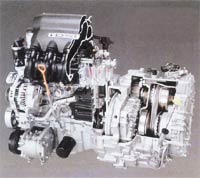
|
Different |
The Differential between VTEC system for Honda Jazz and other Honda’s series.
HONDA JAZZ’S VTEC
SYSTEM.
The Honda's New Jazz is packed with technical innovation, including a revolutionary new powertrain. The engines form the second wave of the new generation of i-series units, which already includes the 200bhp, 2.0-litre i-VTEC fitted to the Civic Type-R.
Called i-DSI (dual and sequential ignition), the powerplant comes in both 1.2
and 1.4-litre versions and uses a radical new twin-spark ignition system with
just two valves per cylinder. It improves efficiency and power while reducing
fuel consumption and emissions.
When fuel and air enters the cylinder of an engine through the inlet valve,
designers concentrate on optimising the swirl of the mixture to ensure fuel is
atomised thoroughly and evenly. But however well the combustion chamber has been
designed, the amount of swirl varies depending on revs and throttle opening.
New i-DSI engine uses twin spark to improve power and reduce fuel
consumption

To
overcome this, the i-DSI engine fires its two sparking plugs at different times
to ensure the mixture burns thoroughly whatever the prevailing conditions. At
lower engine speeds, the spark plug nearest the inlet valve is fired much
earlier than usual while the plug nearest the exhaust valve is fired later than
usual. At higher rpm, the sparks are fired simultaneously.
The benefit of controlling the timing of each plug individually is that it
increases cylinder pressure as the fuel burns and also allows a high compression
ratio of 10.8:1 without causing any engine knocking.
Honda claims that efficiency levels of the new engines are approaching those of
a modern, direct-injection diesel. Both meet 2005 EU IV emissions standards, the
1.2-litre engine achieving 18.8kpl on the combined cycle and the 1.4 18.2kpl.
Power is impressive, too: the 1.2 delivers 77bhp and 11.3kgm torque, and the 1.4
82bhp and 12.3kgm. The CO2 outputs are 126gm/km and 131gm/km.
The engines are robustly constructed with rigid blocks and several heavy-duty
components to absorb the additional noise created by the high cylinder
pressures. Even so, they weigh eight percent less than the 1.3-litre Logo engine
and are shorter and narrower. Early cars have five-speed manual gearboxes, but a
new semi-automatic seven-speed continuously variable transmission (CVT) is on
the way.
Power: 81 kW @ 6,000 rpm
Torque: 143 Nm @ 4,800 rpm
Honda has developed a light, compact engine quipped with a
Honda
engineers sought to develop a SOHC, 16-valve, 1.5-litre VTEC engine with the
best balance of power output, fuel efficiency and ultra-low emissions.
The
Jazz 1.5-litre engine has a peak power of 81kW @ 6000rpm and 143Nm @ 4800rpm,
and achieves Low Emission Vehicle (LEV) status.
Numerous
measures were taken to reduce friction, including an offset cylinder design,
roller type rocker arms, low tension and ion plated piston rings, streaked main
and connecting rod metal bearing and blade-type chain tensioner.
To
minimise the engine's weight and dimensions, the engineers designed the
1.5-litre VTEC engine with a compact cylinder head, hollow camshaft, plastic
intake manifold and stainless pipe exhaust manifold.
The
air-conditioner compressor is mounted on the oil pan to make the best use of the
compact engine bay. The 1.5-litre engine also has a front intake and rear
exhaust layout to maximise space.
The
cylinder block has uses an offset design, which means the crank pin axis and the
piston pin axis are both offset from the cylinder's centre line so that the
piston's side force is minimised at the piston position where the combustion
reaches its peak. This allows a minimum of friction loss.
Another
benefit of the offset design is lower fuel consumption - the piston speed is
relatively slow in the first half of the expansion stroke, which improves
thermal efficiency and, as a result, lower fuel consumption.
The
1.5-litre VTEC engine employs a compact designed VTEC system. The rocker arms
are made of aluminium and each is fitted with the needle roller bearing to
reduce friction.
The
VTEC pistons are incorporated into the roller shaft, enabling the rocker arms to
be light and compact.
Between
2,300 to 3,600 rpm, VTEC piston engages the two intake rocker arms together. The
engagement speed is variable, depending on the input sensor signals from the
VTEC management system.
The
success of the Jazz concept is the result of many different elements and
technological advances, but playing a fundamental role is the petrol engine that
delivers outstanding torque, exceptionally low CO2 emissions and class-leading
fuel economy.
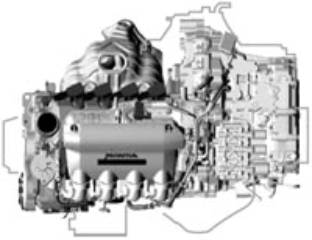
Several Type of VTEC
DOHC
VTEC
The pinacle of VTEC implementation is the DOHC VTEC engine. The first engine to benefit from VTEC is the legendary B16A, a 1595cc inline-4 16Valve DOHC engine with VTEC producing 160ps and first appearing in 1989 in the JDM Honda Integra XSi and RSi.
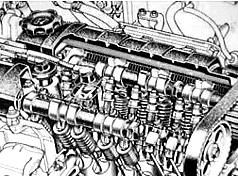
Examine the diagram of a typical Honda DOHC PGM-Fi non-VTEC engine on the left, in this case the 1590cc ZC DOHC engine. Note that each pair of cam-lobe and their corresponding rocker arms though adjacent, are spaced apart from each other.
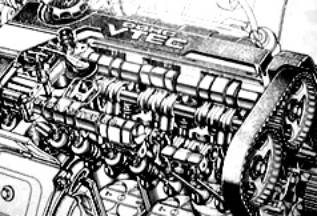
In
the DOHC VTEC implementation, Honda put an extra cam/rocker in between each pair
of intake and exhaust lobes/rockers. The three cam/rocker assemblies are now
next to each other. The new middle lobe is the "wild" race-tuned
cam-lobe. Using VTEC to link up all three rocker arms together, Honda is able to
use either the mild or the wild cam-lobes at will.
DOHC
VTEC implementations can produce extremely high specific outputs. The B16A for
standard street use first produced 160ps and now 170ps. In the super-tuned B16B
implementation used for the new JDM EK-series Honda Civic Type-R, 185ps was
produced from the same 1595cc.
DOHC VTEC can also easily offer competitive power outputs to turbocharged engines for normal street use. For eg, the E-DC2 Integra Si-VTEC produces 180ps from the 1797cc DOHC VTEC B18C engine. This compares favourably to the 1.8l version of the RPS-13 Nissan 180SX which uses a 1.8l DOHC Turbo-Intercooled engine which produced 175ps.
An
alternative implementation of VTEC for high (versus very high) specific output
is used in Honda's SOHC engines. SOHC VTEC engines have often been mistakenly
taken as a 'poor' second-rate derivative of DOHC VTEC but this is not the true
case. An SOHC engine head has advantages of a DOHC head mostly in terms of size
(it is narrower) and weight. For more sedate requirements, an SOHC engine is
preferable to the DOHC engine. SOHC VTEC is a power implementation of VTEC for
SOHC engines with the express intention of extracting high specific output.
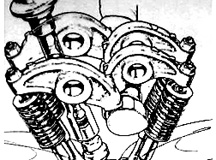
Examine
the diagram of a standard SOHC cam assembly on the right. Note that the pair of
intake rocker arms are separated but adjacent to each other.
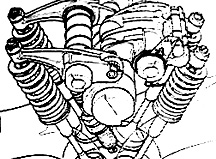
In the SOHC VTEC implementation (diagram on the right), Honda put a
wild-cam lobe for the intake valves in the space between the two rocker arms.
A
novel implementation of VTEC in SOHC engines is the VTEC-E implementation (E for
Economy). VTEC-E uses the principle of swirling to promote more efficient
air-and-fuel mixing in the engine chambers. VTEC-E works by deactivating one
intake valve. Examine the diagram below.
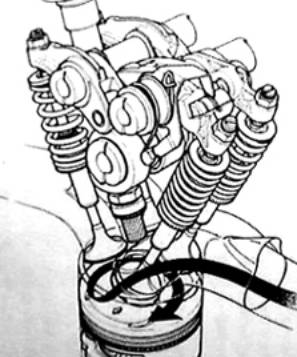
In the SOHC VTEC-E implementation, only one intake cam-lobe is implemented on the camshaft. Actually it is really a flat "ring". In operation this means the relevant rocker arm will not be activated causing the engine to effectively work in 12-valve mode. This promotes a swirl action during the intake cycle. VTEC is used to activate the inactive valve, making the engine work in 16-valve mode in more demanding and higher rpm conditions. Honda was able to implement air-fuel mixture ratios of more than 20:1 in VTEC-E during the 12-valve operating mode.
The SOHC VTEC-E engined EG-series Civic ETi is able to return
fuel consumptions of as good as 20km/litre or better!!
Examine the SOHC VTEC and SOHC VTEC-E implementations. The clever Honda engineers saw that it is a logical step to merge the two implementations into one. This is in essence the 3-stage VTEC implementation. 3-stage VTEC is implemented on the D15B 1.5l SOHC engine in which the VTEC-E mechanism is combined with the power VTEC mechanism.
Many
of us probably has laughed at the poor ignorant layman who said "I want
power AND economy from my Honda". We know of course that power and economy
are mutually exclusive implementations. Honda decided not to abide by
this rule. Now, with 3-stage VTEC, we get BOTH power and economy !.
The
diagram below illustrates the 3-stage VTEC implementation. The intake rocker
arms have two VTEC pin actuation mechanisms. The VTEC-E actuation assembly is
located above the camshaft while the VTEC (power) actuation assembly is the
standard wild-cam lobe and rocker assembly.
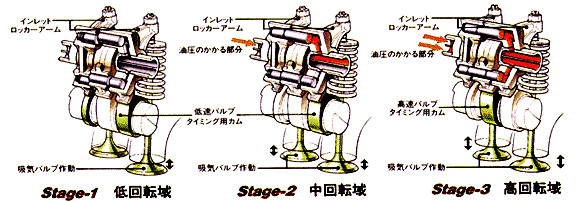
Below
2500rpm and with gentle accelerator pressure, neither pin gets actuated. The
engine operates in 12V mode with very good fuel combustion efficiency. When the
right foot gets more urgent and/or above 2500rpm, the upper pin gets actuated.
This is the VTEC-E mechanism at work and the engine effectively enters into the
'2nd stage'. Now D15B 3-stage works in 16V mode (both intake valves works from
the same mild cam-lobe).
Stage
2 operates from around 2500rpm to 6000rpm. When the rpm exceeds 6000rpm, the
VTEC mechanism activates the wild cam-lobe pushing the engine into the '3rd
stage', the power stage. Now the engine gives us the full benefit of its 130ps
potential !
The
3-stage VTEC D15B engine is used on the current EK-series JDM Civic/Civic Ferio
VTi/Vi together with Honda's new Multimatic CVT transmission. Stage-1 12V or
"lean-burn" operation mode is indicated to the driver by an LED on the
dashboard. The 2500rpm cutover from lean-burn to normal 16V operation in fact
varies according to load and driver requirements. With gentle driving, lean-burn
can operate up to 3000rpm or higher. Stage-3 may not always be activated. The
Multimatic transmission has a selector for Economy, Drive, and Sports mode. In
Economy mode for eg, the ECU operates with a max rpm of around 4800rpm even at
Wide-Open-Throttle positions.